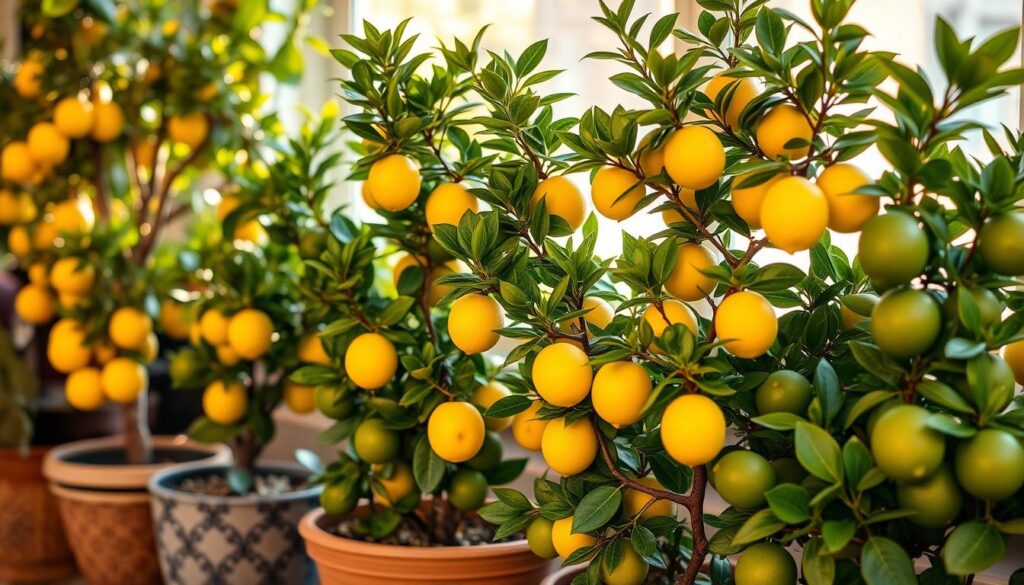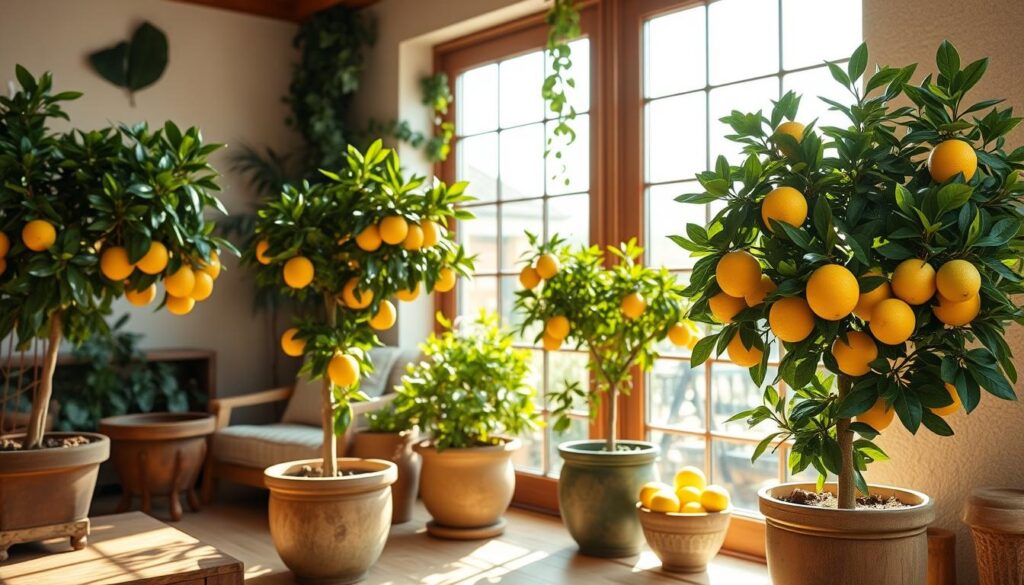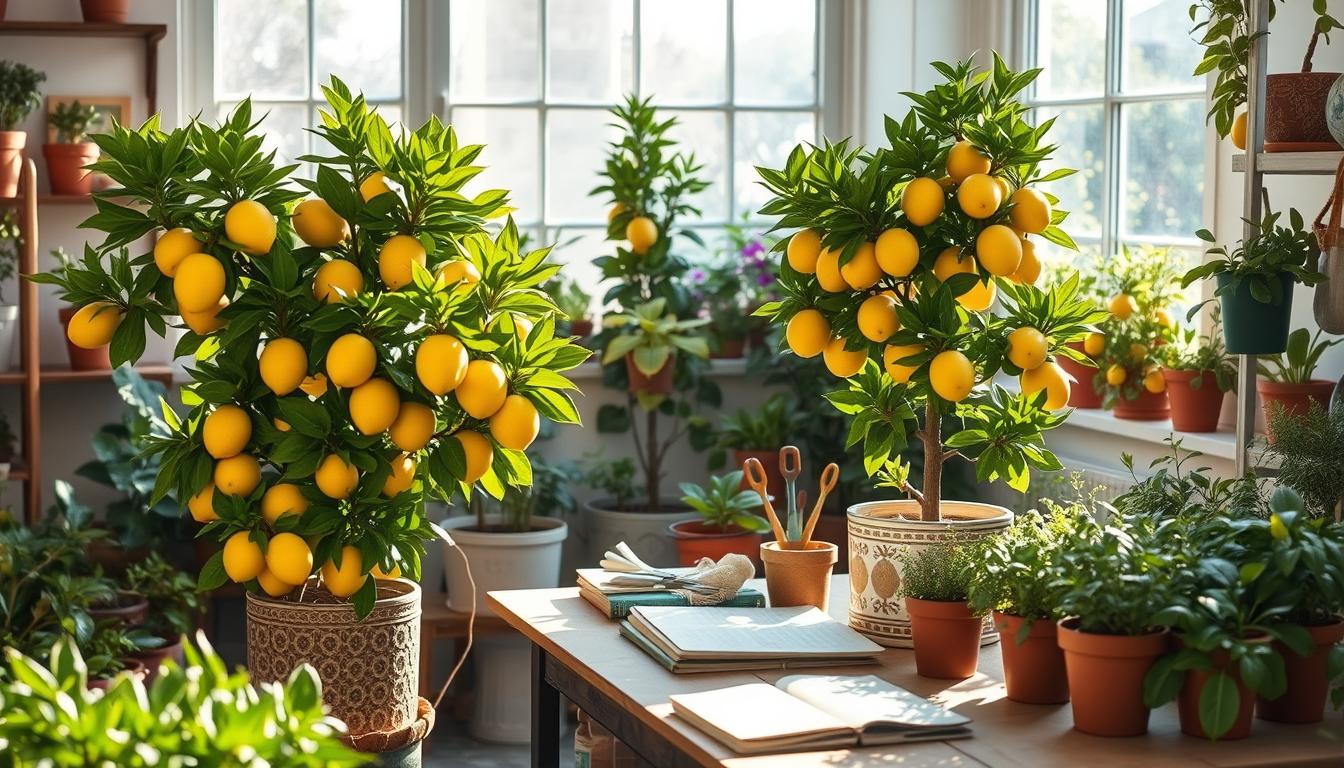Welcome to your journey of Indoor Citrus Mastery! In this article, I will guide you through growing lemons and limes indoors. It’s key to know the indoor citrus growing tips for success. Dwarf citrus trees can grow well indoors, bringing greenery and tasty fruits all year.
As we explore The Complete Guide to Growing Lemons and Limes Indoors, you’ll learn a lot. You’ll find out how to pick the right varieties and the best care for them. This includes Indoor Lemon Tree Care and Best Practices for Indoor Lime Growing.
In the next sections, I’ll share detailed advice on growing indoor citrus plants. You’ll learn about the right growth conditions, potting, watering, and care. Soon, you’ll enjoy the fruits of your labor right at home.
Key Takeaways
- Explore essential steps for growing lemons and limes indoors.
- Learn about the benefits of dwarf citrus varieties for indoor gardening.
- Understand the role of proper light and temperature in indoor citrus growth.
- Familiarize yourself with potting and soil considerations for optimal health.
- Identify best practices for watering your indoor citrus trees.
- Discover effective fertilization strategies to nurture your citrus plants.
- Recognize common pests and how to prevent them for healthy growth.
Understanding Citrus: An Introduction
Citrus fruits have a long history, coming from four original species. These fruits, like lemons and limes, grow well indoors. This method lets me enjoy fresh citrus even in cold places like Illinois.
For over 4,000 years, people have grown citrus in Southeast Asia. Now, we have many varieties that grow well indoors. To grow citrus indoors, it’s important to know their needs.
- Citrus trees need 8-12 hours of sunlight each day.
- They grow best in temperatures between 55°F-85°F.
- Water them regularly, especially in summer. Water deeply once a week is best.
Choosing the right soil is key for growing citrus indoors. A mix of citrus or cactus soil with compost works well. Also, using organic fertilizer helps them grow strong from spring to fall.
Learning about indoor citrus growing has made my gardening better. It also connects me with others who love gardening. For more tips and resources, visit GardenBeginner.com.
Choosing the Right Varieties for Indoor Growth
Choosing the right citrus varieties for indoor growth is key. I pick dwarf options that fit my home’s space well. These varieties are easy to care for and grow well indoors.
Popular Indoor Citrus Species
The Improved Meyer Lemon is a top choice for indoor growth. It’s hardy in cooler temperatures and can produce fruit all year. Other great options include:
- Bearss Lime: Known for its larger fruit compared to other limes.
- Kaffir Lime: Valued for its aromatic leaves that enhance various dishes.
- Calamondin: Offers a unique tart flavor suitable for drinks and culinary creations.

Different Varieties of Lemons and Limes for Indoors
Each lemon and lime variety has its own needs. The ‘Eureka’ lemon is great for zesting and juicing. The ‘Improved Meyer’ lemon is a top choice for indoor fruit trees.
Other notable varieties include:
| Variety | Characteristics | Care Requirements |
|---|---|---|
| ‘Trovita’ Orange | Sweet flavor, juicy and medium-sized | Needs bright light and regular watering |
| Kumquat | Small, tangy fruits that can be eaten whole | Thrives in a well-draining mix and moderate sunlight |
| ‘Ponderosa’ Lemon | Large, fragrant fruit with a strong citrus aroma | Requires acidic soil and consistent moisture |
Understanding each variety’s needs is key for indoor citrus care. I ensure they get the right light, water, and nutrients. With proper care, my indoor citrus garden thrives.
For more tips and detailed guidance, check out this useful contact page for additional insights on indoor citrus care.
The Complete Guide to Growing Lemons and Limes Indoors
Growing lemons and limes indoors can be very rewarding. To succeed, I need to know and follow key steps for indoor citrus trees. It’s important to create a space that feels like their natural home.
Essential Requirements for Indoor Citrus Trees
There are a few key things to focus on:
- Light: Citrus trees need 8 to 12 hours of bright light daily. Placing them near a south-facing window works best.
- Temperature: They do well in temperatures between 65°F and 85°F. Keeping this range helps them grow sweet fruit.
- Humidity: These trees like a more humid environment than usual. I use humidifiers or group plants to keep it moist.
Light, Temperature, and Humidity Needs
Getting the light, temperature, and humidity right is crucial. Here’s what’s best for indoor citrus:
| Condition | Requirement |
|---|---|
| Light | 8-12 hours of bright light daily |
| Temperature | 65°F – 85°F |
| Humidity | Above 40% recommended |
As I care for my indoor citrus, I’ve learned that growing citrus indoors is easier than I thought. By providing enough light, keeping it warm, and checking humidity, I help my trees grow well. This way, they can produce tasty lemons and limes right in my home.
Potting and Soil Considerations
When Growing Citrus Trees Inside, picking the right potting mix and container is key. A mix that drains well is vital, as citrus trees don’t like wet roots. A mix made for citrus or cactus helps keep roots healthy by improving drainage and air flow.
Best Potting Mix for Citrus Trees
I suggest a mix of high-quality potting soil, coarse sand, and perlite in equal parts. This mix holds moisture well but drains excess water. You can also add perlite or pumice to regular potting soil. These changes help your indoor lemon tree thrive.
Choosing the Right Pot Size and Drainage
Choosing the right pot size is also crucial. A pot with holes for drainage prevents water from pooling. For small Meyer lemon trees, a 12-inch diameter pot is best. A 5-gallon plastic pot, 12-15 inches tall, is ideal for its size and stability.
My experience shows that a slightly larger pot than the root ball is best. Repotting every two years after pruning keeps the tree healthy and productive.

For more gardening tips, check out affiliate programs and their impact on gardening content.
Watering Best Practices for Indoor Citrus
Keeping the right moisture level is key for my indoor citrus trees’ health. Knowing how to water them well can really help them grow strong. By following the Best Practices for Indoor Lime Growing, I make sure my citrus gets the best care.
How to Maintain Proper Moisture Levels
I let the top inch of soil dry before watering again. This stops the roots from getting too wet, which can hurt the tree. When it’s warmer or more humid, I water more often. A regular watering schedule helps keep the moisture just right for growth.
Signs of Overwatering and Underwatering
It’s important to know when I’m watering too much or too little. Yellow leaves mean too much water. Dry, droopy leaves mean not enough. Spotting these signs helps me adjust my watering to keep my trees healthy.
Nurturing Your Indoor Citrus: Fertilization Tips
It’s key to give your indoor citrus trees the right food for their health and fruit. Knowing what they need helps them grow well. My experience shows that these trees love nitrogen, especially.
Fertilize them every 4-6 weeks when they’re growing. This helps their leaves grow and boosts fruit production.
Understanding Nutritional Needs of Citrus Trees
Fertilizing right is crucial for their green leaves and fruit. A balanced fertilizer with the right N-P-K ratio is needed. Organic and citrus-specific fertilizers, like those with a 2-1-1 ratio, work well.
I use slow-release fertilizers to feed them steadily. This keeps them healthy all season.
Best Fertilizers for Indoor Citrus Success
Choosing the best fertilizer is key for indoor lime growing. I prefer balanced citrus fertilizers, like 10-10-10 or 14-14-14. Regular use gives them the nutrients they need to thrive and fruit.
Also, watch how your tree reacts and adjust the fertilizing as needed. This helps them grow their best.
Light Requirements for Citrus Growth
Knowing what light citrus plants need is key for growing them indoors. Enough light is crucial for their growth and fruit production. Indoor citrus needs a steady light source to grow well and produce good fruit.
Types of Light Sources for Indoor Citrus
Natural sunlight is the best for citrus plants. They need at least 6 hours of direct sunlight a day, but prefer 8-12 hours. If natural sunlight is not enough, I suggest using grow lights.
Full-spectrum LED grow lights are great because they mimic sunlight. They provide the ultraviolet spectrum plants need for health. These lights help with photosynthesis, boosting growth and fruiting.
Managing Seasonal Changes in Light Availability
Seasonal changes can change how much natural light citrus plants get. In winter, I move my plants closer to windows or adjust my grow lights. This ensures they get enough light.
Checking light exposure regularly helps keep my citrus trees healthy. This way, they grow well even in cold months. Following these tips helps my plants thrive all year.
Common Pests and Diseases
Caring for indoor citrus trees, like lemons and limes, means watching out for pests and diseases. Common pests include Red Spider Mites, Thrips, and Scale insects. Red Spider Mites can turn leaves bronze, while Thrips harm plant tissues.
It’s important to check leaves and soil often to spot problems early. To fight pests, I use products like Safer® Brand Insect Killing Soap or Monterey Horticultural Oil.
Identifying Common Citrus Pests
Mealybugs, Whiteflies, and Leafrollers also trouble indoor citrus plants. Mealybugs leave sticky residues on fruit, while Whiteflies can cause leaves to turn color or fall off. Quick action with natural treatments keeps my indoor lemon tree healthy.
Managing pests like Orange Dog Caterpillars involves hand removal and organic sprays. This keeps my plants safe.
How to Treat and Prevent Citrus Diseases
For indoor lime growing, it’s key to watch out for diseases like citrus scab and HLB (Huanglongbing). Look for raised lesions or leaf blotches to spot these diseases. Copper-based fungicides and removing sick plants are common treatments.
I also keep growing conditions right and clean leaves to stop diseases. For more tips, check out pest and disease care resources.



Leave a Reply